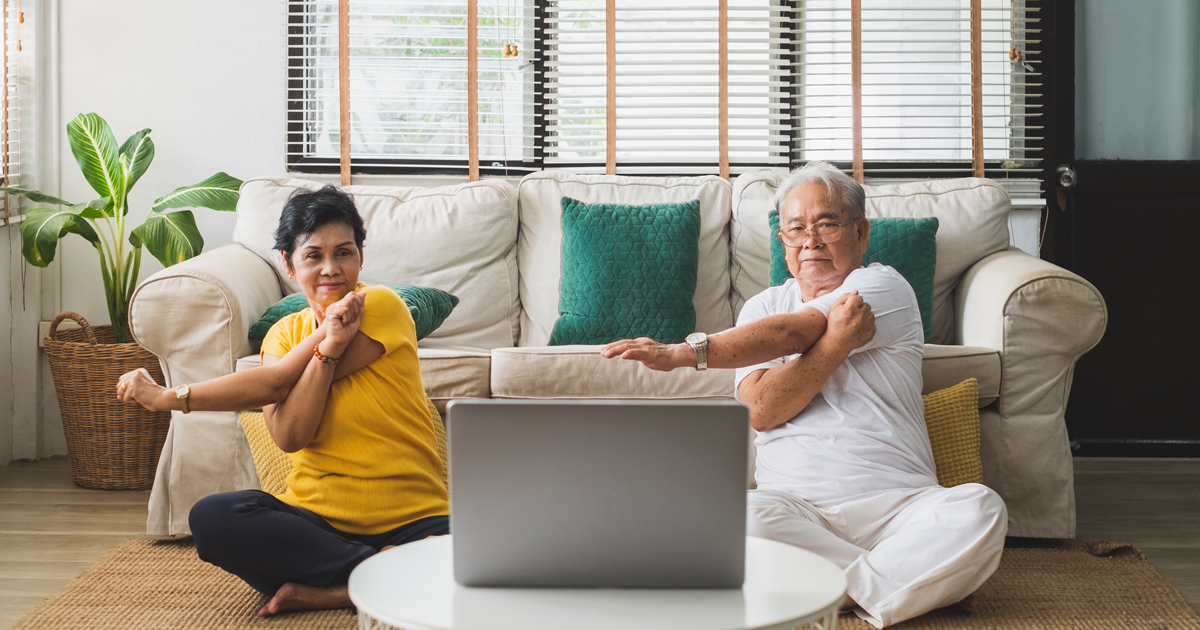Asset Publisher
4 Tips to Help Older Adults Stay Active Indoors in the Winter
By Julie Hayes | 12/15/2020

An older couple doing stretches in front of a laptop
Winter may bring all the many delights of the holiday season, but along with it often comes cold and flu season concerns, increased cases of COVID-19, severe weather and plunging temperatures. Even during more traditional winters than this one, the temptation to stay in bed and hibernate like bears until the warm weather comes back is hard to overcome. After all, when “the weather outside is frightful,” what’s better than relaxing in front of a delightful fire?
But no matter how cold it gets, it’s important to keep our bodies and minds active and resist the temptation to turn days spent at home into a total shutdown of our energy and motivation. For older adults, staying active has a wide array of benefits such as improvement to disease prevention, mental health, quality of living and overall wellbeing. Regular activity can also help lessen the effects of the social isolation and winter blues many of us are experiencing during the pandemic.
Here are just a few ways to stay active this winter:
1. Find ways to exercise indoors
Start by thinking of what options are available to you in your home environment. If you have open space in your home, you can consider trying an online workout. Many fitness YouTube channels have videos specifically for older adults, and organizations like SilverSneakers also adapted to shift classes to an online format during the pandemic. If you have friends you enjoy working out with, arranging a workout over a video sharing platform may also help you stay engaged and motivated.
If you don’t have space you can dedicate to more extensive routines, you can take advantage of simple alternatives, such as chair exercises, lifting small hand weights or even just doing walking laps to and from different rooms of the house.
Remember to consult a doctor before planning an exercise routine to discuss what is safe and appropriate for you to engage in.
2. Take on a household project
There’s always something that needs doing, and while having a to-do list can be frustrating when you have things you’d rather do, these kinds of activities can be blessings in disguise when your schedule opens up. Whether it’s cleaning out the closet or hanging up new photos of your family, these household tasks can keep you busy, productive and in motion.
3. Don’t neglect brain exercises
Having an active mind can be just as important as having an active body. In fact, regular mental stimulation can be key in protecting against memory loss and can help you maintain important motor skills.
Memory boosting activities can take many different forms, and you can adapt them based on your own interests. Doing crossword puzzles, playing chess, crafting, puzzling out a solve-it-yourself mystery and answering game show questions are all examples of things you can try out in your day-to-day life. In the spirit of lifelong learning, you can also expand your knowledge by watching a TED talk, listening to audiobooks, watching a documentary or reading a book on a new subject.
4. Volunteer
Changes brought about by the COVID-19 pandemic expanded the number of volunteer opportunities you can take part in from the comfort of your own home, such as becoming a Secret Santa to children in need, making blankets for veterans or even tutoring students in need. Here at Benjamin Rose Institute on Aging, we also have opportunities to make wellness calls to older adults who may be socially isolated. To find virtual opportunities, you can look into the virtual volunteering boards of VolunteerMatch and Points of Light for more ideas.
Related Assets
Suggested Reads
4 Memory Boosting Brain Exercises for Older Adults
Most of us know that physical exercise is important to keep the body healthy and strong, but what we may not know is that our brains also benefit from exercise. Keeping our brains active and alert can often be essential to our wellbeing as we transition into o...
Benefits of Exercise for Older Adults
We’ve all heard it a hundred times: exercise is important! When we hear this, many of us automatically think of the role of exercise in weight management, but do we think about the other benefits of exercising? Centers for Disease Control and Prevention highli...
Benefits of Volunteering
Are you looking to learn a new skill, become more connected in your community, or engage with others? Whatever your reason may be, volunteering could be a great option for you! Volunteers are crucial to many organizations, as they provide fresh, new ideas, cos...
Incorporating Exercise into a Loved One’s Routine
Most of us know that physical activity is good for our health, and an important part of a weekly routine. But what about the loved ones we care for? Do they know the many benefits of physical activity? If we are in great shape and physically fit, our loved on...
